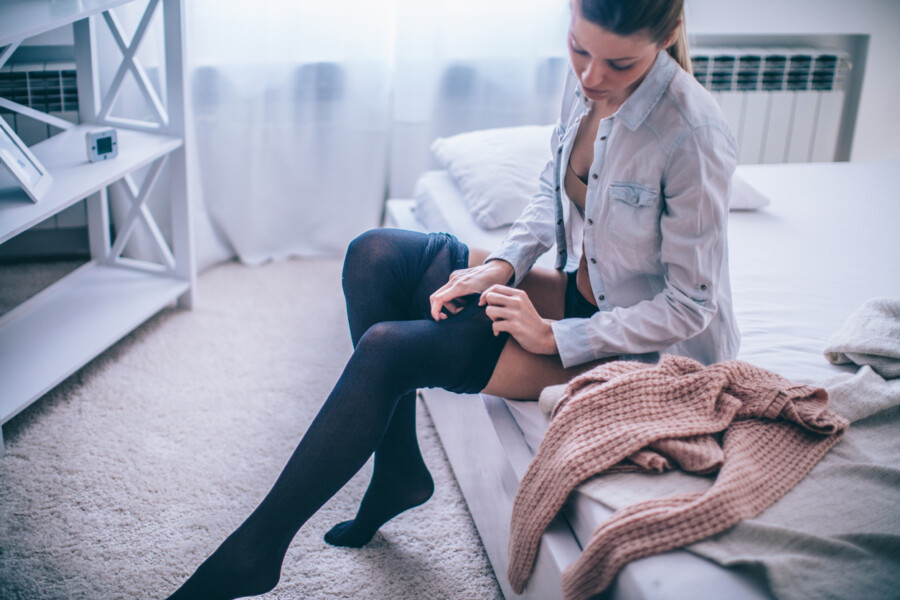What is compression therapy?
“Compression therapy is a tool used for a variety of lower extremity problems,” says Dr. Schul. He explains that “compression creates a ‘compartment’ in the legs that do not allow the pressure of backward flowing veins to exert tissue effects on the skin.” In other words, the pain and inflammation caused by the reversal of blood flow through damaged leg valves (a condition known as reflux) are minimized when wearing compression socks. This is especially true while standing or sitting for extended periods.
Snug-fitting stretchy compression socks helps the vessels work better by applying gentle pressure to the lower legs that create a compartment. This compartment supports venous return and lessens symptoms of venous hypertension. Blood circulation is improved because—by improving the blood flow in the deep system, blood flows upward toward the heart more efficiently—versus venous (blood) pooling as pressure builds in varicose veins.
Does compression “cure” varicose veins?
In short, no.
Dr. Schul explains that a compression sock “creates a barrier/compartment and acts as a crutch” for someone suffering from symptoms of vein disease that can control the painful symptoms of the disorder. However, using standing , doctors discovered that compression does not stop the backward direction of blood flow in superficial veins (that is, closer to the skin’s surface).
Compression does, however, make a difference in the deep vein system. The compression causes the deep veins to become smaller, the blood flow in the deep veins becomes faster, and the arteries dilate. In doing so, compression creates a “compartment” that increases blood flow to the lower extremities and enhances blood flow out of the lower extremity and back toward the heart, as we expect normal veins to perform.
Who should use compression socks?
Dr. Schul recommends that all people who have a standing or sitting occupation wear compression socks, calling it a “healthy vein habit.” Dr. Schul acknowledges that he wears compression daily because he spends his day sitting and talking with patients or standing while performing surgery. He also wears compression while traveling, but not when he is off duty.
Compression socks as a diagnostic tool
Although many symptoms in the lower extremities are related to varicose and spider veins, not all symptoms in the lower extremities are vein-related, says Dr. Schul. We commonly see patients with multiple concerns (e.g. painful joints, back problems, neuropathy, etc.) Wearing compression socks is a useful tool to help figure out what leg symptoms may be vein related, especially when it is not immediately clear that the symptoms are related to the varicosities (enlarged veins).
In essence, when compression therapy, walking, and elevating the limbs help to relieve the symptoms of vein disease, it can be easily deduced that the person will indeed benefit from vein treatment.
When is compression therapy best used?
Dr. Schul reviewed the conditions in which compression therapy is indicated. These include:
- Open wounds of the lower extremities (that is, legs, ankles, and feet)
- Venous leg ulcers
- Lymphedema
- Avid athletes
How does compression help athletes?
For high-impact athletes, compression stabilizes muscle fibers, enhancing oxygen delivery to the tissues. Compression increases arterial blood flow by helping arteries carry more oxygen-rich blood to the body's tissues. The athlete benefits from the combination of enhanced venous return, increased oxygenated blood flow to the tissues, and reduction of muscle vibration during the activity.
“There is enough knowledge in the use of compression for performance athletes that it is now an essential part of their gear to optimize performance,” adds Dr. Schul.
Do you have varicose vein symptoms? We can help.
Caused by increased pressure in the veins, varicose veins can cause aching, throbbing, swelling, itching and burning sensations and the feeling of leg heaviness and fatigue. A progressive disease, varicose veins may worsen without treatment and can lead to skin changes, sores, rashes, and open wounds that do not heal.
If you are experiencing any of these symptoms, visit Best Compression Socks Sale for more information.
